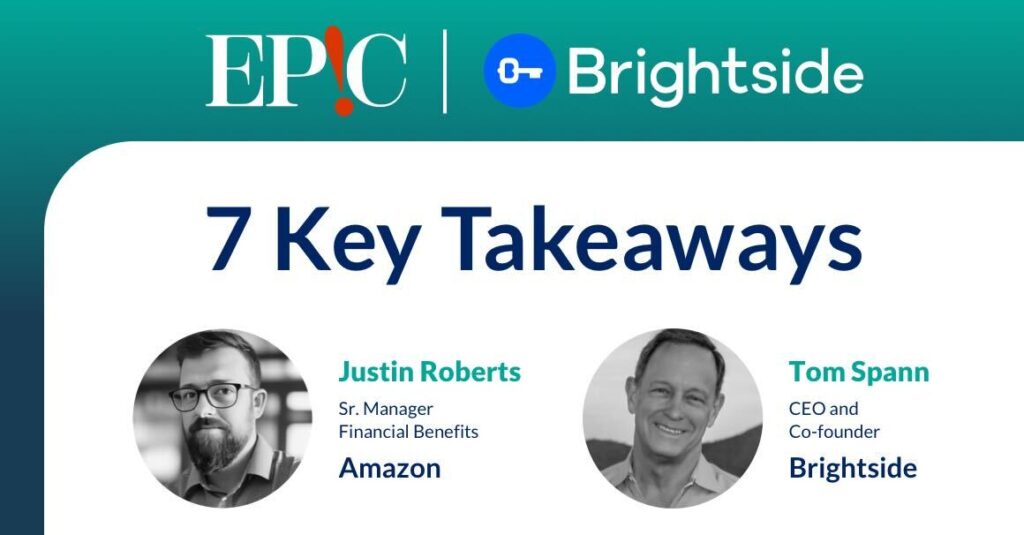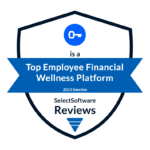If you’re using financial wellness benefits to support your frontline workers, are you seeing any improvements in their financial situations? Most employers don’t – but it’s not their fault. These benefits aren’t designed to address this financially vulnerable group’s financial struggles, let alone improve their financial health.
Brightside CEO and Co-founder Tom Spann and Amazon Sr. Manager, Financial Benefits Justin Roberts recently led a session at the Elevate People, Ignite Change (EPIC) conference addressing how employers can improve frontline employees’ financial health – and see measurable business impacts – by thinking beyond financial wellness.
Here are seven key takeaways from their thought-provoking session:
1. Poor financial health costs thousands of dollars per employee
Financial illness is expensive for impacted employees – and your company. Studies show it costs $3,000 to $4,000 per employee, due to factors such as higher healthcare costs and lower productivity.
2. Don’t assume what your frontline employees need
Amazon presented its frontline employees with a wide range of potential benefit options and asked them to rank those they most wanted. “Those financial benefits just kept coming to the top of our employees’ want list,” said Roberts.
To determine the exact type of financial help they needed, Amazon also asked employees specific questions about their financial lives, such as: “Have you ever had to decide between buying groceries and paying your electric bill?”
Roberts said he’s seen many benefits leaders get caught on a specific idea of what they think will improve employees’ financial health, such as an emergency savings program, when in fact, the employees have very different financial barriers they need help overcoming first.
Don’t make the common mistake of assuming what your frontline employees need. “I can’t express how important it is to talk to your employees. That’s how we ended up coming to look for a financial health solution,” said Roberts.
3. Don’t expect financial education to improve financial health
A meta-analysis of financial literacy programs revealed that financial education had a 0.1% impact on financial behaviors – with even weaker impacts in lower income populations.
What did work in that study? Bite-sized education delivered in the moment. “People want to know what to do next. They don’t want to peruse the website for education,” said Spann. “It’s really important to understand that financial wellness has been the certified financial planner (CFP) model. Financially struggling employees think they’re going to be told: ‘You’re managing your money wrong. This is your fault.’”
He explained that the financial wellness approach makes them feel great shame as opposed to being made to feel that their financial benefit is there to support their needs. “Then, you can help them become financially literate through the process,” said Spann.
4. Help frontline employees with urgent problems
Roberts explained that when Amazon started looking for a frontline financial health benefit, it prioritized one that could “stop the bleeding,” take care of employees’ financial emergencies, and then build on top of that to improve their financial health.
Financial wellness solutions typically pair an employee with a skilled professional, such as a CFP, but they’re not a relevant product for financially struggling workers. “Financially sick people very often need urgent care and they need primary care. They don’t need the wellness stuff, which is focused on financial planning for folks who have money to invest,” said Spann.
5. Choose a financial health provider whose values align with your organization
As a customer-centric company, Amazon wanted a financial health partner that would apply the same customer-first approach to Amazon employees. Of additional importance, they wanted a solution that was not going to take a kickback for any of the solutions employees used; would not limit the amount of time an employee could spend with their Financial Assistant; and would connect the employee with the same dedicated Financial Assistant on every interaction, to help build trust. All of those factors led it to Brightside.
6. Support frontline workers with real people who can offer real solutions
Roberts spoke about two Amazon frontline workers experiencing financial emergencies, including homelessness and lack of transportation access to get to work. Brightside’s human-led approach and direct connections with local resources in each employee’s community led to immediate solutions, including free food, safe housing, and transportation – all of which cost the employees nothing.
“You don’t want someone to send you a list of homeless shelters when you’re in that situation. They need a real person to tell them the steps, and that it’s okay that they’re in this situation,” said Roberts.
In addition to the employees’ urgent needs, Brightside helped them address the root causes of their financial struggles and made it easy to take small steps to improve their lives. Both employees are now thriving at work, financially stable, and moving forward in their financial health journey.
7. Don’t mistake program engagement for success
Roberts stressed that benefits leaders should know exactly what their frontline financial health program is built to do and the outcome they want to see.
“With Brightside, we know the engagement rate that we want, but that’s just the surface. We know we want a certain percentage of our people saving in their emergency savings account. We know we want these families to engage in three to four different financial cases; it tells us that they came in for an emergency but are now working on goals such as spending plans and long-term savings. We know that we want to provide X number of value per family and we hold ourselves accountable to that,” said Roberts.
For every dollar Amazon puts into its financial health program with Brightside, it sees about $3 of value back to the employee.
Roberts added that Amazon identifies what it thinks it would see in a financially healthy person within its workforce as one way to measure business impacts: “We think we would see more hours worked. We think we would see less attrition. We think we would see better safety – and we have seen those things.”
To learn more about Brightside Financial Care or see the model in action, click here.





